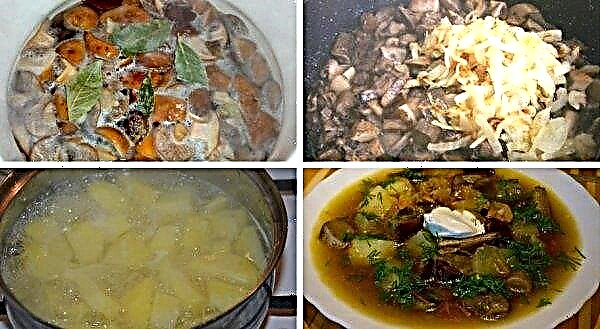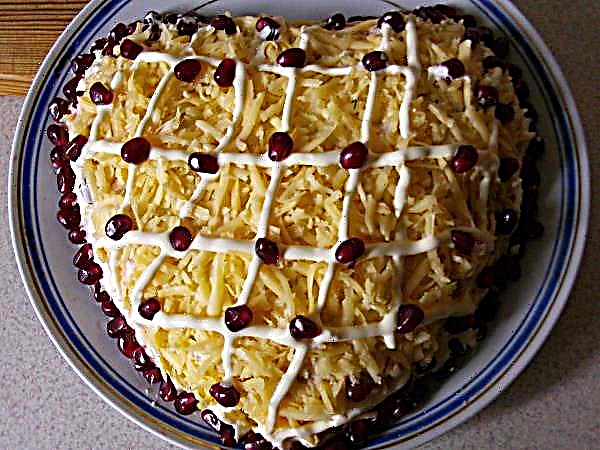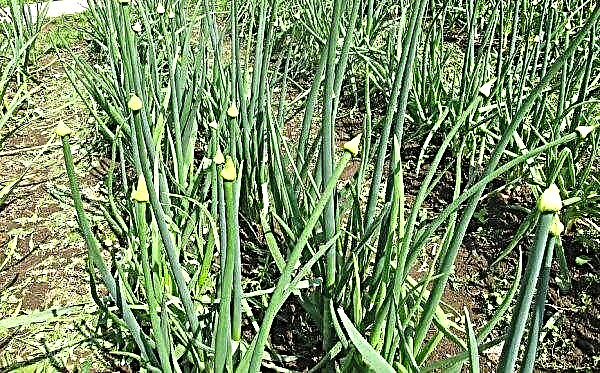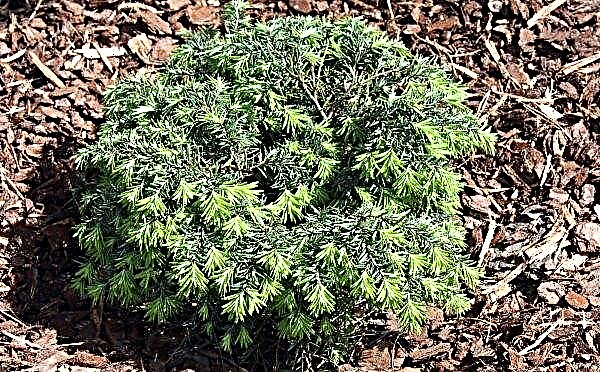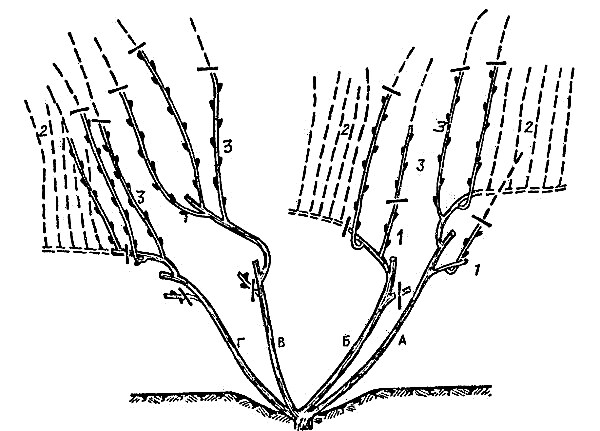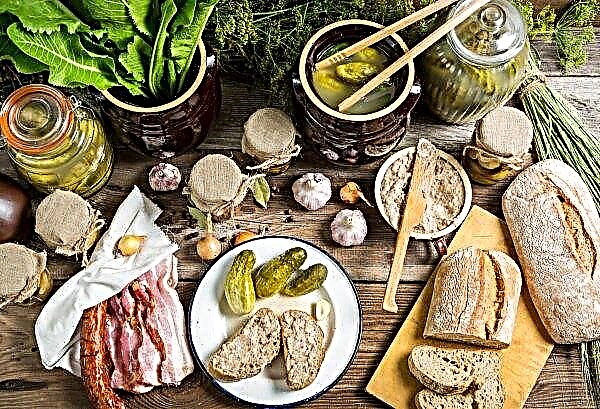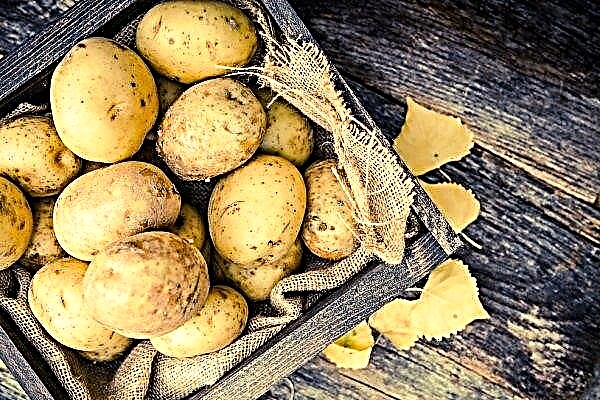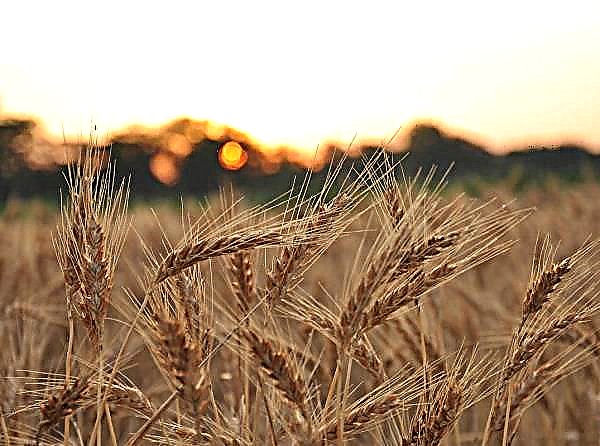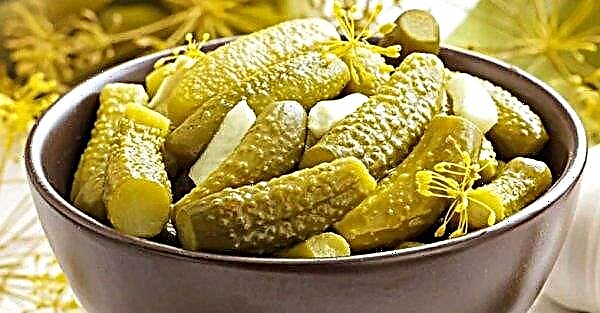Sadko is one of the most promising and promising gooseberry varieties bred for cultivation, including in regions that are not the most suitable for these purposes. Sadko showed remarkable winter hardiness, resistance to many typical diseases, unpretentiousness in care.
History and description of the variety Sadko
Sadko is little studied because of his youth. However, amateur gardeners and professional breeders have already managed to appreciate the strengths of the variety and its few drawbacks.

Gooseberry Sadko was the result of breeding work on crossing varieties Lada and seedling 329-11. Bred at the All-Russian Institute of Horticulture. The hybrid is still in the phase of variety testing, however, it is already recommended for cultivation in the central regions, as well as in other areas in which this culture is bred in principle.
The bush is of medium height, rather strong, slightly spreading. Often there are bushes Sadko compressed type. The variety is characterized by a high ability to form new shoots: they grow straight, very long, have an average thickness.
Did you know? Experts consider English yellow to be the best sweet gooseberry variety. In addition to the fact that the variety is distinguished by an excellent sweet dessert taste with a slight acidity, it has a phenomenal yield - up to 20 kg from one bush.
The description of the variety will be incomplete, not to mention the small number of thorns, which, moreover, are weak and short. The tops of young shoots, as well as the old branches of thorns do not have. Foliage of medium size, emerald color, which by the autumn becomes red. The surface of the leaves is rough, embossed. The contours of the leaves are dotted with large blunt teeth.
Characteristics of berries, ripening time, yield
The berry is large, the weight reaches 3.5–7 g, spherical or oval, sometimes they can be pear-shaped. The color is light red, with a rather thick layer of wax coating and well visible veins. Taste is good; experts rate it 4 out of 5.
In the compote, the peel of the berries does not burst, the color is not lost. The marketable qualities of berries are also noted:
- sugar - up to 7.5%;
- acids - 2.2%;
- vitamin C - 25 mg / 100 g.
Sadko has a medium-late ripening period. The plant begins bearing fruit from the fifth season of life and has a high yield - up to 6 kg from one bush. For commercial cultivation, you can collect up to 10.5 kg / ha. It has excellent resistance to winter frost, has a stable immunity to powdery mildew and spotting.
Advantages and disadvantages
- According to the reviews of gardeners and the observations of specialists, we can draw conclusions about the advantages inherent in the variety:
- tolerates drought, frost and temperature changes, both seasonal and daily;
- a bush of small size and a small number of almost dull thorns significantly facilitate the collection of fruits;
- good immunity to diseases inherent in culture;
- universal purpose of berries;
- wonderful presentation, transportability and keeping quality.
- Disadvantages specific to Sadko:
- strongly sour notes of taste are felt;
- thick peel;
- fruiting in full begins only with the fifth season.
Growing Features
It is recommended to do this in a nursery that has good reviews and a reputation. Buying planting material in such a place, you will protect yourself from the purchase of low-quality products. In nurseries you can buy seedlings with a closed root system, suitable for planting at any time of the year. Using the method of vegetative propagation, it is possible to obtain planting material of good quality, which will retain varietal characteristics.
 To get a gooseberry crop as soon as possible, it is better to purchase strong healthy two-year-old seedlings.
To get a gooseberry crop as soon as possible, it is better to purchase strong healthy two-year-old seedlings.
Gooseberries are well rooted both from cuttings and grown by layering. Sadko shoots grow straight, it is not easy for them to gain a foothold in the ground. However, such difficulties harden the young growth, as a result, strong plants are obtained, adapted to specific conditions.
Important! Vegetative division is applied only to bushes, not older than 6 years old. Digging up an adult plant in order to separate the part for reproduction from it is possible only in an exceptional case - gooseberries are long and hard to recover after such a procedure.
Seat selection
When choosing a landing site for Sadko, it is advisable to look for a site that meets these requirements:
- the most suitable soil is loam with a neutral pH;
- the landing site should be on a hill or gentle slope (preferably south or southeast), well lit by the rays of the sun;
- a good addition would be the presence of wind protection on the north side (trees, tall shrubs, buildings);
- places with a high level of groundwater, as well as lowlands for cultivation are not suitable, in this case it is necessary to build an embankment;
- gooseberries should not be planted where currants grew before it.

Landing and care
Saplings with open roots are planted in autumn and spring. Plants with a closed root system are planted throughout the year. Below are described in detail the activities for the autumn landing of gooseberries. The procedure performed in the spring is no different, but it is better to prepare the site for spring planting and to fertilize in the autumn.
Did you know? Gooseberries have been known in Russia for more than a thousand years, much longer than in Europe. About how popular the fruit was in Russia is evidenced by its name in the Azerbaijani language “Rus Alchas”, meaning “Russian cherry plum” in translation.
Landing procedure:
- To clear the place for gooseberry landing, to free from parts of plants, including the remains of roots, stems, leaves and fruits. This should be done 2-3 weeks before the gooseberry is planted. It is good to dig the soil to the depth of the bayonet of the shovel, break up all the large clods of earth to a fraction the size of a cherry.
- For each square meter of the site, add a bucket of humus and rotted manure, 10 tbsp. l superphosphate, 3 tbsp. ammonium nitrate and a shovel of sifted wood ash. Spread the fertilizer mixture evenly over the surface of the earth and drip it shallow.
- 15-17 days after fertilizing, digging landing trenches. To do this, mark the rows, the distance between which should be 1.7–2 m. The depth of the ditches is at least 50 cm, the width is twice as large as the diameter of the roots of the seedling.
- The top layer (20–25 cm) of the soil selected from the ditch is laid separately, it is necessary for the preparation of a fertile substrate. The rest of the earth selected from the pit will be necessary in order to fill the trench after planting.
- The topsoil is mixed in equal parts with compost. For every 3 buckets of the mixture, add 1 cup of complex mineral fertilizers and ash.
- The bottom of the trench is covered with a layer of drainage 8–10 cm thick, consisting of crushed brick, crushed stone, broken tiles, expanded clay.
- The recommended distance between adjacent bushes is 1.3–1.5 m. It is at this distance, one from the other at the bottom of the trench should be poured mounds from the prepared mixture. The specified distance must be maintained between the peaks of the knolls (seedlings will be placed on them), and not between their edges.
- At the top of the embankment a seedling is vertically arranged, the root system is distributed along the slopes. The plant is sprinkled with ordinary soil (not a prepared mixture, but the one that remained), ramming it.
- Falling asleep into the trench, you must monitor the root neck - it should be 3-4 cm above the ground. If the neck is located in the ground, this can lead to the death of the plant.
- After the ditches are filled and tamped, the gooseberries must be watered (a bucket of water for each bush) and cut to a height of 35–40 cm, but so that no more than 5 buds remain on one shoot.
- The final step will be to mulch the landings with sawdust, straw or peat. Mulch helps to retain moisture (but not its excess) in the soil and inhibits weed growth.

After the gooseberry is planted, the main measures for its care consist of the following procedures:
- watering;
- fertilizer application;
- pruning and bush formation.
The variety reacts normally to a lack of moisture, more precisely, that Sadko tolerates its excess worse. With the usual amount of precipitation, additional moisture is not required.
Watering may be necessary at such stages of the growing season:
- bloom;
- fruit loading;
- the initial stage of shedding leaves;
- plentiful pre-winter watering that protects the plant from frostbite.
Sadko is a self-fertile variety that does not require pollinating plants. In order for the crop to bring abundant harvests as long as possible, it needs regular top dressing. If the pre-planting fertilizer application has been completed in full, the first 2 years there is no need to feed gooseberries.
Video: Gooseberry Sadko
Starting from the third year of life, fertilizers are applied according to this scheme:
- Spring nitrogen supplementation. It is carried out before the swelling of the kidneys. As top dressing, use one of these tools: ammonium nitrate, urea, ammonium sulfate. One bush will need a solution of 1 tbsp. any of the listed funds in a bucket of water. This solution needs to water the soil around the bush.
- Shortly before ovary formation. The nitrogen fraction necessary for the plant at this stage is minimized (the growth of green mass is no longer needed), and the need for potassium necessary for the formation of fruits increases. Apply potassium nitrate, potassium chloride, potassium sulfate. The use of such a drug has proven itself well: dissolve 20 g of ammonium and potassium nitrate and 30 g of superphosphate in 10 l of water. With this volume, water the root area of one bush.
- The last fertilizing carried out before harvesting is superphosphate. Dissolve 2 tbsp. fertilizers in one bucket of water, water the basal area.

Approximately according to this scheme, organic fertilizers can be applied:
- In the spring, mullein or bird droppings rich in nitrogen. In one bucket of water, dilute 500-600 g of well-rotted manure or bird droppings, leave in a shaded, warm place. After 5-8 days, when you feel a characteristic smell, the product is ready. Before use, mix the infusion well and water the soil around the bush, one bucket is designed for 2 plants.
- Ash is used before flowering and the formation of fruits begins. Dilute in a bucket of water one shovel of sifted ash, mix well, with this volume of fertilizer, water the soil around each bush.
Pest and Disease Control
Although Sadko - a variety recently bred, he has already managed to confirm his resistance to powdery mildew and spotting. In addition, gooseberries have a high immunity to many other diseases that are most often threatening the culture.
Important! Sadko is capable of stably high fruiting for 15–17 years.
According to the observations of gardeners, the risk of diseases arises in case of violation of the rules of agricultural technology: too abundant watering, leading to stagnation of moisture, excessive thickening of plantings (lack of pruning and thinning), the presence of weeds. Diseases are easier to prevent than to treat them, so the timely implementation of preventive measures significantly reduces the chances of diseases.
Prevention consists of the following activities:
- spraying plantings Bordeaux fluid solution (2%) or "Fitosporin";
- timely feeding (measure helps increase immunity);
- thorough thorough cleaning of biological residues (foliage, stems, parts of roots and branches, the remains of old mulch and weed grass) during autumn work;
- use only healthy seedlings grown in a famous nursery.

Trimming and shaping a bush
There are a large number of methods and types of pruning bush. The procedure is divided into stimulating, healing, formative.
The main and most effective methods of forming green mass, the use of which will be sufficient:
- After planting, all seedlings are cut: strong so as to leave no more than 5 buds (3-4 is better). Weak and thin are cut so that no more than 3 buds are on the stem, preferably 1-2 pcs.
- The next season leaves 5 of the most powerful and healthy growths, the rest of the shoots are cut to ground level.
- In the future, the pruning procedure is performed during the dormant period of the plant: in spring - before the start of active sap flow, in autumn - after the leaves are dropped.
- Remove all sick, dry, weak, damaged, and in the spring and frostbitten branches. If the part of the branch located closer to the root can be saved, it is better to do this by trimming only the top.
- Sections with a diameter of 1 cm and more should be covered with garden var.
 If you want to get a crop of larger berries, after the formation of the ovaries, gooseberries need to be cut again. All young shoots are cut to the first fruit brush so that the upper kidney is directed outward.
If you want to get a crop of larger berries, after the formation of the ovaries, gooseberries need to be cut again. All young shoots are cut to the first fruit brush so that the upper kidney is directed outward.
In addition, you can thin out the brushes directly, leaving each with a pair of fruits. An adult, well-formed Sadko bush, consists of 8–10 strong healthy stems growing almost vertically upward, with a slight deviation to the outside.
Wintering
Sadko is prepared for winter frosts after all autumn care activities are carried out:
- site cleaning;
- fertilizer application;
- pre-winter watering;
- trimming.
In the central regions of Russia, throughout Ukraine, Sadko should not be hibernated for wintering. In more northern latitudes, landing for the winter should be well mulled. It is better to prepare mulch from straw, peat and ripened sawdust taken in equal parts. The layer of mulch is 10–13 cm.
 If there is a threat of attack by rodents, on top of the mulch lay the spruce branches. After the first snow falls, you need to collect it from other sites and throw the gooseberry plantings.
If there is a threat of attack by rodents, on top of the mulch lay the spruce branches. After the first snow falls, you need to collect it from other sites and throw the gooseberry plantings.
If your region has especially harsh winters, or if there is a small amount of snow in winter, the bushes are covered with non-woven material such as Spanbond. The material on the plants does not need to be tightened, it should be located freely, holding a large amount of air underneath.
Did you know? In English, the name gooseberry sounds like "gooseberry", which means "goose berry." But even the British themselves cannot voice a reliable version of the origin of such an unusual name for the berry.
The most dangerous pests for gooseberries:
- spider mite;
- shoot aphid;
- a firegun;
- sawfly.
As preventive measures that prevent the appearance of pests, foliar treatment of plants is carried out before the buds begin to bloom. For these purposes, spraying with a solution is used. "Fufanona."

In the event that pests on the plant are detected, use, according to the instructions, insecticides and acaricides of the type Actellik, Karbofos, Wofatox, Hostakvik.
Alternative methods, the use of which can scare off unwanted insects:
- spraying gooseberry plantings with horseradish infusion, dusting with ash;
- against aphids, the bushes are treated with a soap solution;
- planting tomatoes, garlic, mint between the rows of gooseberries;
- cultivation near plantings of elderberry, calendula, marigold.
Harvesting and storage
To keep Sadko's crop fresh as long as possible, the fruits should be harvested at the stage of technical maturity. This phase occurs 10-15 days before full maturity (consumer ripeness). If you harvest even earlier, the gooseberry does not fully ripen, you can use it only for processing. In order to eat fresh berries immediately, without additional processing, you need to collect it fully ripened.
 Berries collected in the phase of technical maturity, it is better to collect in batches of not more than 5-6 kg. Harvest in containers is necessary so that the contents do not reach the top edge of the container by 2-3 cm.
Berries collected in the phase of technical maturity, it is better to collect in batches of not more than 5-6 kg. Harvest in containers is necessary so that the contents do not reach the top edge of the container by 2-3 cm.
In the event that you plan to harvest at a time, the berries that grow on the outer branches are the first to pick. To break off the fruits from the branches located inside, the outer shoots are slightly bent to the ground. Fruits are best removed from branches with a small part of the stem.
Fruits in the stage of full (consumer) ripeness are collected in containers, filling them with no more than 80% of the volume. At the same time, it is desirable that the mass of the crop collected in one tank does not exceed 3-3.5 kg.
Important! Berries that show the slightest sign of damage or illness should not be placed with the total weight of the crop.
Harvesting should be done in dry weather, pouring berries from one container to another is undesirable - this negatively affects the keeping quality and transportability of berries. If in your cellar or basement the air temperature is close to 0 ° C and the humidity level is about 90%, a correctly harvested crop can be stored in such conditions for up to one and a half months.
Sadko tolerates freezing well. To do this, its fruits are carefully washed, dried, laid out in bags or containers and placed in the freezer.

Despite the low knowledge of the variety, gardeners have already managed to draw conclusions about the prospects of Sadko. Bright beautiful berries with good taste and marketability will not leave indifferent gooseberry lovers. An important role is played by Sadko's resistance to diseases that pose a threat to other varieties.


